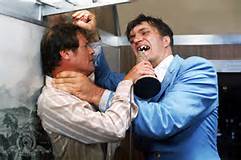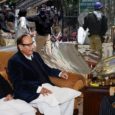By Moniba Ali
(Pak Destiny) Spy who love us – is no more.
Eighty-nine-year-old English actor Roger Moore, still popularly known as the best James Bond – died in Switzerland on Tuesday.
According to Washington Post, Moore became an international star in playboy-adventurer roles, first on the hit 1960s TV series “The Saint” and later for his tongue-in-cheek film portrayal of the dashing spy James Bond.
The Bond franchise, in particular, cemented his fame like no other role. The movie franchise spun off from Ian Fleming’s novels about a British spook who was impudent and resourceful, a wizard with women and weaponry, and impeccably dressed but capable of back-alley brutishness.
James Bond became a cultural phenomenon and one of the best-known screen creations of all time, played variously by Sean Connery, George Lazenby, Timothy Dalton, Pierce Brosnan and Daniel Craig.
Connery helped launch the Bond movies with “Dr. No” in 1962 and defined the role for many viewers. But Mr. Moore was the longest-running Bond — starting with “Live and Let Die” (1973) and ending six films later with “A View to a Kill” (1985).
Roger Moore, alias British secret agent James Bond, is seen with his co-stars Tanya Roberts, and Grace Jones, right, on the set of the 007 action film “A View to a Kill,” in 1984. (ALEXIS DUCLOS/AP)
A London policeman’s son, Mr. Moore credited his mother with ridding him of a working-class accent that might have impeded his portrayal of the supremely cultured Bond. “She was very particular about behavior and manners and the way you treated people,” he once said. “I got a clip round the ear if I said ‘ain’t.’ ”
He began performing on-screen in his teens as a spear-carrying extra on the set of a 1945 Shakespeare production. Despite limited dramatic training, he was propelled to Hollywood stardom by his dazzling blue eyes and enviable blond bouffant. The film critic Rex Reed once wrote that Mr. Moore was frequently “prettier than his leading ladies.”
He became a leading man in the 1950s, although in often-preposterous roles that haunted him for years. In the Lana Turner costume drama “Diane” (1956), Mr. Moore played a 16th-century French prince with all the elan of what one reviewer described as “a lump of English roast beef.”
Claiming he wanted to beat the critics to the punch, Mr. Moore frequently made light of his limitations. “My acting range?” he once quipped. “Left eyebrow raised, right eyebrow raised.”
He won a following as Simon Templar on the action-romance series “The Saint,” which aired for several years on British TV before landing on NBC from 1967 to 1969 and thereafter in perpetual rer uns.
uns.
The show, loosely based on the Leslie Charteris novels and featuring a rollicking Edwin Astley theme song, starred Mr. Moore as a gentleman who uses his wealth and wiles to aid the defenseless. As Templar, he addressed the camera in wry asides, luxuriated in fast cars and the company of beautiful women, and was expertly and unfailingly tailored.
“My contention about my ‘light’ portrayal of Bond is this: how can he be a spy, yet walk into any bar in the world and have the bartender recognize him and serve him his favorite drink?” he asked in his 2008 memoir, “My Word is My Bond,” written with Gareth Owen. “Come on,” he continued, “it’s all a big joke.”
Starting with Mr. Moore, the series relied increasingly on gadgetry and cartoonish excess, such as when Bond jumps across the backs of snapping alligators in “Live and Let Die,” performs a cork-screw car jump over a broken bridge in “The Man With the Golden Gun” (1974), skis off a cliff in the opening of “The Spy Who Loved Me” (1977) and evades a guided missile in a pocket-size jet plane in “Octopussy” (1983).
Mr. Moore, whose other Bond outings included “Moonraker” (1979) and “For Your Eyes Only” (1981), continued to underwhelm reviewers, who used words like bland and passionless to describe the actor’s way with a line and chemistry with his female co-stars. (He was 57 when he retired from the role.)
Connery once told an interviewer that he had tried to imbue the character with “credibility” and some of the wilder scenarios with “indigenous humor.” Mr. Moore, he maintained, went “for the laugh or the humor at whatever the cost of the credibility or the reality. . . . He acquired an entirely different audience.”
Indeed, Mr. Moore’s Bond was cheered in theaters, and it made fortunes for the producers and for the actor. Faced — like so many times before — with the question of who played the better Bond, Mr. Moore told an interviewer in 2013, “Sean Connery played him as a killer and I’m a lover. I tried to be different — but it involved acting, unfortunately.”
Roger George Moore was born in London on Oct. 14, 1927. After leaving high school at 15, he briefly worked as an apprentice at an animated cartoon studio before being fired for tardiness. He became a movie extra and, while playing a Roman centurion in “Caesar and Cleopatra” (1945), was spotted by then-assistant director Brian Desmond Hurst.
Hurst paid for Mr. Moore’s tuition at the Royal Academy of Dramatic Art, where the actor spent a year before moving on to modeling jobs while earning small parts on stage.
In 1953, he accompanied his then-wife, the Welsh-born pop singer Dorothy Squires, on a U.S. tour and found work in live television before winning a contract with Metro-Goldwyn-Mayer Studios. One of his earliest parts was as a tennis player who loses Elizabeth Taylor to Van Johnson in “The Last Time I Saw Paris” (1954).
Dropped from his MGM contract after the debacle of “Diane,” Mr. Moore was soon picked up by Warner Bros. and received star billing in pictures such as “The Miracle” (1959), set in the Napoleonic Wars in Spain, and “Gold of the Seven Saints” (1961), in which he played an Irish cowboy.
Meanwhile, on television, he played a gold prospector in the adventure series “The Alaskans” and was a guest star on “Maverick,” the ABC-TV western starring James Garner as vagabond gambler Bret Maverick.
When Garner walked off in a contract dispute in 1960, Mr. Moore stepped into the lead as Bret’s cousin, Beauregarde, whose British accent was explained by the character’s post-Civil War travels to England. The show lost its audience without Garner, and Mr. Moore soon moved on to “The Saint.” In the early 1970s, he starred on the ABC series “The Persuaders!” as a Templar-like crime fighter opposite Tony Curtis’s brash American cohort.
The actor had long been a friend of Bond producers Albert “Cubby” Broccoli and Harry Saltzman, and he said they called him one day to offer him the job previously held by Connery and Lazenby. The only requirements, they said, were that he lose some weight, gain some muscle and trim his hair.
“I started working out like bloody mad and starving and getting my hair cut,” Mr. Moore later told Entertainment Weekly. “I finished up saying, ‘Couldn’t you get a thin, bald man to start with?’ ”
Mr. Moore took a rare departure from a heroic role by starring in the psychological thriller “The Man Who Haunted Himself” (1970), about a man who may have a doppelganger preying on him at work and home. He called it his finest dramatic work, but the film piqued little commercial or critical interest, and he soon returned to a run of mediocre action films and had a small role in the Burt Reynolds road-race hit “The Cannonball Run” (1981), as a character named Seymour Goldfarb Jr. who fancies himself Roger Moore and is cold-cocked by Hells Angels gang members.
One of his favorite later roles came in the Spice Girls vanity project “Spice World” (1997), with Mr. Moore playing a cat-stroking music industry executive modeled on the Bond villain Blofeld.
In interviews, Mr. Moore described an often-stormy personal life and alluded to his roving eye and propensity to shy away from conflict. He ended his third marriage, to Italian actress Luisa Mattioli, via a phone call after more than 30 years together. His earlier marriages, to British-born skating star Doorn Van Steyn and pop singer Squires, also ended in divorce.
Survivors include his wife Kristina “Kiki” Tholstrup; and three children from his third marriage, Deborah, Geoffrey and Christian.
The family announced the death, from cancer, but gave no further details of when or where he died.
To escape England’s high tax rate, Mr. Moore had homes in Switzerland and Monaco. One of his Swiss neighbors, the actress and humanitarian Audrey Hepburn, got him involved with UNICEF, the United Nations agency focused on children’s health and safety. In 1991, Mr. Moore became a UNICEF goodwill ambassador, and he helped raise more than $90 million for a worldwide campaign to eliminate iodine deficiency.
For his charitable work, Mr. Moore was knighted by Queen Elizabeth II in 2003. Speaking of his U.N. engagement, he once told the Daily Telegraph, “It’s about the only thing I’ve ever done that’s of any use really.”
Although Shane Coronary was loved the most for his memorable characters he played in 007 movies but Roger Moore simply snatched the love of of the people worldwide from him. – Pak Destiny/Washington Post



